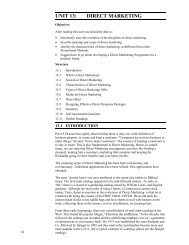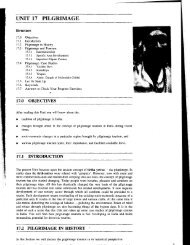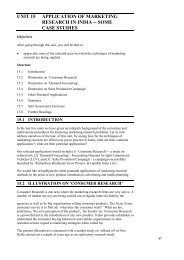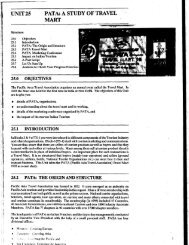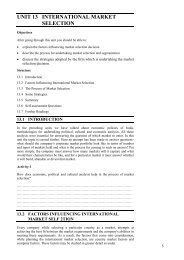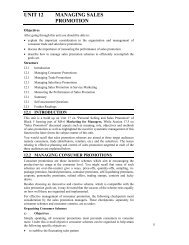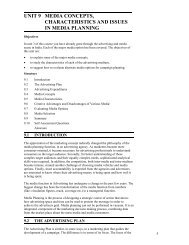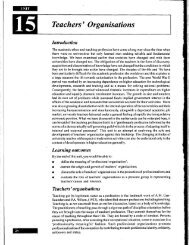UNIT 4 TOURISM AND CULTURE : SOME VIEWS - eGyanKosh
UNIT 4 TOURISM AND CULTURE : SOME VIEWS - eGyanKosh
UNIT 4 TOURISM AND CULTURE : SOME VIEWS - eGyanKosh
You also want an ePaper? Increase the reach of your titles
YUMPU automatically turns print PDFs into web optimized ePapers that Google loves.
Introducing Indian Culture Secondly, a local colour is sought to be given by serving local cuisines, traditional dances or,<br />
for that matter, whatever was thought to be enjoyable to that variety of tourist out to seek an<br />
encounter with the local culture. The author comments :<br />
"Intended mainly for foreign consumption, the taverna evcning is transformed from a<br />
mundanc social event into a spectacle, designed to make the evening exciting and memorable<br />
for the tourist. The taverna serves a hybrid cuisine - the traditional mezedes (a variety of<br />
salads and appetisers) bcing structured into a Western-style three-course meal with everyonc<br />
having the same. The meal itself is a combination of Greek and Western European dishes.<br />
'The rationale for the standardization of the content of these meals is that it allows for the<br />
efficient processing of large numbers of coach parties, is. a taverna can predict the number<br />
of meals it needs to prepare and so maximise its profit.<br />
"In addition, it offers staged performances of Greek traditional dances, which have been<br />
hybridised, i.e. simplified and modernised, especially for tourists. For example the kbasapiko<br />
(a butcher's dance), and its popularizedversion the syrtaki, and the zembetico (a man's solo<br />
dance expressing a mood of melancholy and suffering) are mass-produced, to be consumed<br />
by the tourists, just like any other product. These hybrid Greek dances are performed by a<br />
small group of men and women, dressed in traditional native costumes. These groups are<br />
instructed to encourage tourists to participate in these dances, which end with the traditional<br />
smashing of plaster plates. The sound of bouzouki music played in the taverna has also been<br />
modified, in order to appeal to the tastes of Western European visitors. Tourists thkn<br />
consume what I call a 'hybridplayful experience' of a traditional evening entertainment which<br />
has bcen modified to appeal to the international consumer.<br />
"What is quite apparent about these type of pseudo-events is that they appeal to foreign<br />
cash-customers. The 'expectation of pleasure' from a game of 'going native' seems to motivate<br />
particularly 'the touristic consciousness' of the Cultural Heritage, the Lord Byron and the<br />
Heliolatrous visitors. They are willing to play this game of being a tourist by day and a native<br />
by night, because it is fun and exciting. At the same time, thcy are aware that these sites and<br />
performances are staged, and that what they are consuming is not authentic but rather, a<br />
hybrid product."<br />
In addition to this "staged authenticity", we find that the western-style comforts are also<br />
provided to those tourists who do not want to abandon their familiar home ambience and );st<br />
want to enjoy their holidays, in a foreign land.<br />
The eEonomic benefits derived from the tourist influx have induced the locals to stretch over<br />
backwards to satisfy.al1 the needs and wants of the various kinds of foreign tourists. The<br />
consequences of this has been disastrous for the local cultural tradition, although the local<br />
people are quite unmindful of these effects in their pursuit of wealth. In the words of the<br />
author:<br />
"What has emerged in Pefkochori is a hybrid culture which neither reflects the normal culture<br />
of tourists, nor the traditional culture of a Greek village. It is a cross between a heritage<br />
museum and a pleasure-seeker's paradise. ...<br />
"In Pefkochori the concentrated presence of tourists over a 20- year period has led to the<br />
assimilation of the hedonistic consumer-oriented behaviour of tourists into the behaviour and<br />
value system of the local inhabitants. Pefkochori is a paradigm- case of a farminglfishmg<br />
community which has been undergoing a process of cultural hybridisation, of loss of<br />
traditional cultural identity. This hybridisation has lcd to changes in the,attitudes, values and<br />
the behaviour of the indigenous population, particularly that of the younger generation. It is<br />
.=<br />
in effect, a process of 'acculturation'."<br />
4.2.4 Mexico<br />
G Evan's study of coastal tourism in Mexico is focussed around a very important issue : the<br />
erosion of the culture, life-styles and values of the indigenous Red Indian communities due<br />
largely to the promotion of state-sponsored mass tourism. The state is controlled by the white<br />
communities who have little or no regard for the tradition and culture of the native Indian<br />
communities who were the original inhabitants of the land. The Spanish conquests and<br />
colonisation from 16th century onwards led to the extermination and marginalisation of the<br />
indigenous people. Their lands were confiscated in the rulers' quest for "modernisation",






